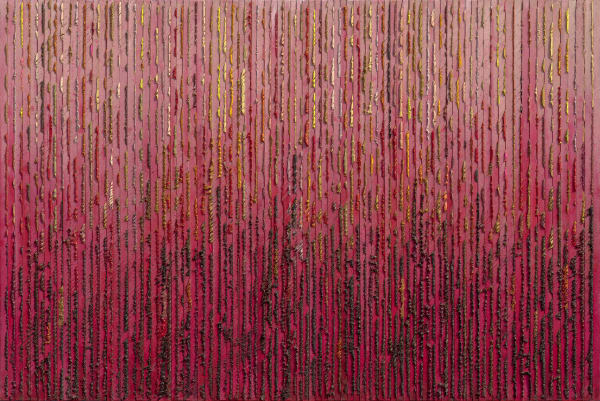Ha Chong-Hyun: Return to Color
“An artist should constantly grapple with color. And I thought I would be able to finally complete the puzzle of my art when I fill in the missing color.” —Ha Chong-Hyun
Tina Kim Gallery is pleased to present Return to Color, a solo exhibition of works by Ha Chong-Hyun (b. 1935), one of the leading members of the Dansaekhwa movement. Marking his third solo presentation with the gallery, the exhibition surveys the last decade of the artist’s practice with new polychromatic works that illuminate a return to color as well as a departure from his foundational, monochromatic Conjunction series first developed in the 1970s. This revitalized body of work will be exhibited alongside selections from the artist’s Post-Conjunction series from 2011. Shown together, the exhibition will examine the artist’s relationship with color, and investigate the philosophy behind the pivotal transitions in Ha’s practice. The exhibition will be on view from May 8 to June 30 2021.
“An artist should constantly grapple with color. And I thought I would be able to finally complete the puzzle of my art when I fill in the missing color.” – Ha Chong-Hyun
Tina Kim Gallery is pleased to present Return to Color, a solo exhibition of works by Ha Chong-Hyun (b. 1935), one of the leading members of the Dansaekhwa movement. Marking his third solo presentation with the gallery, the exhibition surveys the last decade of the artist’s practice with new polychromatic works that illuminate a return to color as well as a departure from his foundational, monochromatic Conjunction series first developed in the 1970s. This revitalized body of work will be exhibited alongside selections from the artist’s Post-Conjunction series from 2011. Shown together, the exhibition will examine the artist’s relationship with color, and investigate the philosophy behind the pivotal transitions in Ha’s practice. The exhibition will be on view from May 8 to June 30 2021.
Ha Chong-Hyun began his Conjunction series in the 1970s and has developed the techniques into a signature style. The word “Conjunction” denotes the physical connection between two significant elements of his practice, his methods and his materials, and how the two are ‘conjoined.’ He started to use burlap in replacement of the more traditional canvas popular after the Korean War. It allows him to approach each painting from the reverse, pushing thick paint through the loose weave. The oil paint then emerges from the front, creating a texture that has become iconic to Ha’s practice.
While Ha is predominantly known for his monochrome paintings, this exhibition aims to bring forth a fresh perspective on Ha’s oeuvre, by presenting his Post-Conjunction series that illuminates a fuller, well-rounded discourse on Ha’s practice. In this series, Ha no longer limits himself to his usual earth-tone color palette. Rather, he opens himself up to a more diverse range of colors, building off of his earlier practice back in the 1960s during his tenure as a leader of the ‘A.G’. (Korean Avant-Garde Association), in which he would introduce the latest art trends to Korean counterparts. During this time, he engaged with abstraction and incorporated ‘Obangsaek,’ the color scheme of the Korean traditional colors of white, black, blue, yellow, and red. While his typical use of muted tones heavily involves the Dansaekhwa movement, a silent protest against the political establishment, his earlier works reflect much more vibrant, even, painterly gestures. Ha would also explore unconventional materials such as barbed wires, newspaper, and plaster, as a direct response to the situation of post-war Korea. Integrating everyday objects into his works, he challenged the traditional notion of painting and blurred the boundaries between painting, sculpture, and performance.
In each Post-Conjunction work, colorful oil pigments seep through each canvas consisting of multiple panels. Before the oozed oil paints would fully dry out, Ha would make labor-intensive marks directly on them in diagonal directions. The canvases themselves are elaborately formed with each wooden panel, which is sealed with cotton cloth and then painted with colorful gradations, connecting one to the other. Here, the artist explores and works with multiple sides of the canvas surface, pursuing his idea of painting as an object ever since the late 1960s. Thus, his practice in this series not only demonstrates the tension between two and three-dimensional forms, but also intensifies Ha’s continuous investigation of materiality and tactility. He combines spirited elements of color from his early work with the gradient, canvas breaking techniques of Conjunction, becoming whole in his totality of expression. Ha finally breaks the threshold of politics and personal, and expresses himself to the fullest without restraints of color, form, and purpose.
Essentially, Ha’s development of Post-Conjunction series further equipped him to expand his vibrant color scheme and painting method to his most recent Conjunction series, in which he applies layers of thick impasto marks that are further highlighted in gradations of paints mixed with white. His intensified yet loose painterly strokes amplify a more tactile appearance of each work amid its visceral surface, connoting Ha’s foremost interest in the pure act of painting. As evident in each new Conjunction series, the works have evolved richer and more diverse in its shades and forms. Still, each work reflects consistent formal qualities through Ha’s vigorous self-reference and profound contemplation on new challenges intertwined. Harkening back to his early practice from the late 1960s and the 1970s in which he would incorporate bright yet natural colors and experiment with space, both Post-Conjunction and new Conjunction series can be measured as the extension of his dynamic, ongoing quest for paintings’ myriad potentials.
-

Best Gallery Exhibitions Summer 2021
Observer June 1, 2021This summer galleries are opening doors and welcoming in art lovers, we picked out the ones you won't want to miss. “Return To Color” with...Learn More -

What Abstraction Can Face Up To
Hyperallergic May 15, 2021Ha Chong-Hyun has survived the many catastrophes that have befallen Korea during his lifetime, and his work is inextricable from his life.Learn More




